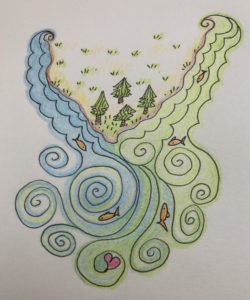
-Illustration © 2022 Jan Ketchel
The conflicting energies of independent ocean currents meet at a point of confluence, such as Cape Agulhas, at the southernmost tip of Africa, where the Atlantic and Indian Oceans come to meet. Sailors experience such points of confluence as particularly hazardous waters to navigate. The challenge is one of equaniminous accommodation of such clashing energies in a living domain of ruthless opposition.
Such is the state of America, and the rest of the world, right now, as we approach the coming crescendo of election day, November 8th. The true, underlying point of confluence has always existed, as all parts of all that is are represented in our greater wholeness. What distinguishes now is the full unleashing of these primal energy undercurrents to the Earth’s surface, exploding the usually dependable walls of civilized restraint.
These currents are archetypal energies whose passions excite numinous fascination. Numinous experience is defined as spiritual awe and ecstasy, a true meeting with the divine. For the human ego, an experience with the energy of the collective unconscious is numinous. Though ego may be threatened with disintegration at such an encounter, it craves contact with its spiritual source.
The conscious experience of leaving one’s body, or communing with a disembodied spirit, is numinous. Some numinous experiences are ecstatic, others terrifying. Nonetheless, the fascination with either can be quite compelling. Apocalyptic and horror movies are frequently blockbuster successes, as vicarious brushes with the terrible of archetypal energies claim their due.
Archetypes are the prototypical gods and goddesses behind our perceptions and emotional relationships in this world. Fear of encounters with authority figures is actually fear of the Old Testament God, Yaweh, in his wrathful mood. Craving the attention and validation from a beloved is actually a numinous hunger for mirroring from the Great Mother goddess, superimposed upon a mere mortal woman or man.
When the archetypes are activated, the passions they arouse demand release, sometimes with fatal consequences. On this Day of the Dead may we be reminded of our human form’s finiteness. Though we crave numinous union with the divine, may we survive it as well.
I approach the coming point of confluence, November 8th, with equanimity. I, like everyone, have my version of what would be best to serve stability in our rapidly changing world. I voted my preference. But now I stand back in even-tempered awe, awaiting the outcome.
I have no attachment to that outcome, whatever it may be. I await it in the spirit of total equanimity. I intend to accept and live the outcome as the majority chooses it to be. I am part of a greater whole and must reside within the developmental level the majority has achieved.
Numinosity is felt in the perilous grasp of the undertow, as well as in the calm of the eye of the storm. Either way, we are in the presence of divine encounter.
Equanimity allows us to truly go with the flow, without resistance. The spirits present on this Day of the Dead remind us of life everlasting, as we cling tightly to our current dream. May we dream on and awaken with equanimity, as we navigate the confluence of now.
Remember this fact: I am free to choose the attitude I will take toward anything I encounter.
With Equanimity,
Chuck

